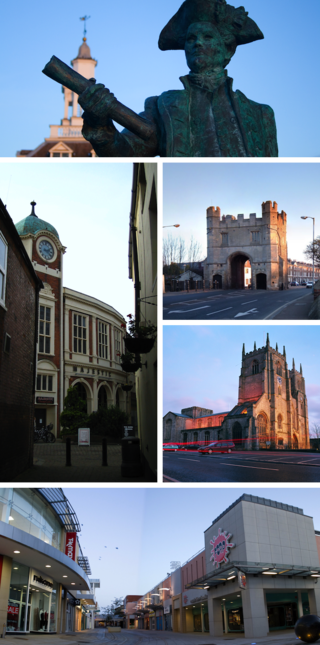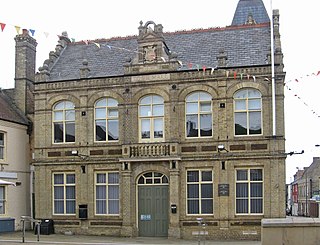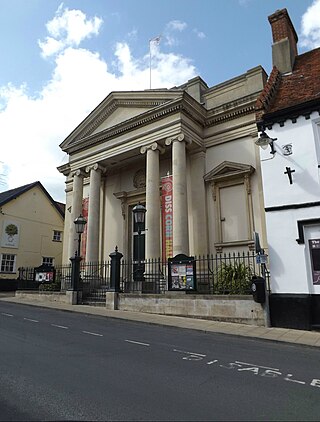
King's Lynn, known until 1537 as Bishop's Lynn and colloquially as Lynn, is a port and market town in the borough of King's Lynn and West Norfolk in the county of Norfolk, England. It is located 98 miles (158 km) north of London, 36 miles (58 km) north-east of Peterborough, 44 miles (71 km) north-north-east of Cambridge and 44 miles (71 km) west of Norwich.

Fakenham is a market town and civil parish in Norfolk, England. It is situated on the River Wensum, about 25 miles north west of Norwich. The town is the junction of several local roads, including the A148 from King's Lynn to Cromer, the A1067 to Norwich and the A1065 to Swaffham.

The Corn Exchange is an events and concert venue located on Wheeler Street in Cambridge, Cambridgeshire, England. The structure, which was commissioned as a corn exchange, is a Grade II listed building.

The Hazlitt Theatre and Exchange Studio, also known as the Hazlitt Arts Centre, is a theatre complex in Earl Street in Maidstone, Kent, England. The oldest part of the complex, which is now used as a shopping complex on the ground floor, and as a theatre venue known as the "Exchange Studio" on the first floor, is a Grade II listed building.

The Corn Exchange is an events and concert venue located in the Market Place in Newbury, Berkshire, England. The structure, which was commissioned as a corn exchange and is now used as an events venue, is a Grade II listed building.

The Corn Exchange is an events and concert venue located on St Paul's Square in the Castle area of Bedford, Bedfordshire, England. The structure, which was commissioned as a corn exchange, is a Grade II listed building.

Corn exchanges are distinct buildings which were originally created as a venue for corn merchants to meet and arrange pricing with farmers for the sale of wheat, barley, and other corn crops. The word "corn" in British English denotes all cereal grains, such as wheat and barley. With the repeal of the Corn Laws in 1846, a large number of corn exchanges were built in England, particularly in the corn-growing areas of Eastern England.

Downham Market Town Hall is a municipal building in Bridge Street, Downham Market, Norfolk, England. The structure, which is managed by Downham Market Town Council, is a Grade II listed building.

The Corn Exchange is a commercial building on Fore Street in Hertford, Hertfordshire, England. The structure, which is currently used as an events venue, is a Grade II listed building.

The Corn Exchange is a commercial building in the Saturday Market, Beverley, East Riding of Yorkshire, England. The structure, which was commissioned as a corn exchange and is now used as a department store, is a Grade II listed building.

The Market House is a commercial building in Church Street in Camborne, Cornwall, England. The structure, which is currently used as a hotel and public house, is a Grade II listed building.

The Corn Exchange is a commercial building in Conduit Street, Lichfield, Staffordshire, England. The structure, which is used as a series of shops on the ground floor and as a restaurant on the first floor, is a Grade II listed building.

The Corn Exchange is a commercial building in Queen Street, Market Rasen, Lincolnshire, England. The structure, which is used as the offices of a firm of charted surveyors, is a Grade II listed building.

The Corn Exchange is a commercial building on Market Hill, Sudbury, Suffolk, England. The structure, which is used as a public library, is a Grade II* listed building.

The Corn Exchange is a commercial building in Angel Street, Worcester, Worcestershire, England. The structure, which is currently vacant, is a Grade II listed building.

The Corn Hall is a commercial building in St Nicholas Street, Diss, Norfolk, England. The structure, which is now used as an arts centre, is a Grade II listed building.

The Corn Exchange is a commercial building in Nottingham Street in Melton Mowbray, Leicestershire, England. The structure, which is now used to provide access to a shopping centre, is a Grade II listed building.

The Corn Exchange is a commercial building in Exchange Street in Harleston, Norfolk, England. The structure, which used as a vintage and antiques emporium until June 2023, is a Grade II listed building.

The Corn Exchange is a commercial building in the Market Place in Hadleigh, Suffolk, England. The structure, which currently accommodates a small business centre, is a Grade II listed building.



















